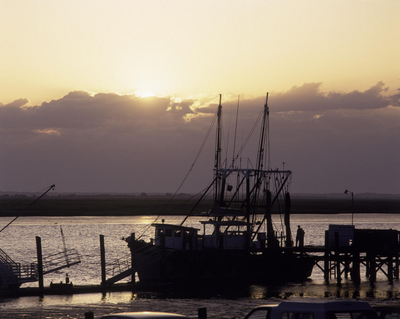Mike Blank, harbormaster at the Port of Brookings Harbor, sums it up this way: “We finally got some relief.”
 BROOKINGS — Mike Blank, harbormaster at the Port of Brookings Harbor, sums it up this way: “We finally got some relief.”
BROOKINGS — Mike Blank, harbormaster at the Port of Brookings Harbor, sums it up this way: “We finally got some relief.”
After a 2006 salmon fishing season that was a financial disaster for fishermen along the Northern California and Central Oregon Coast (on the heels of a severely restricted season in ’05), the 2007 season promises to be closer to business as usual — at least for trollers south of Astoria.
A rebound in the population of Klamath River Chinook salmon prompted the Pacific Fisheries Management Council to declare in April a near-normal season (with some restrictions in September) for salmon fishermen along most of the Oregon coast, while a decline in the number of salmon in the Columbia River is calling for the most constraint on quotas for northern Oregon and Washington fishermen since 1998.
“They’re just now getting what we’ve had for years,” says Blank.
Blank says there are between 30 and 40 salmon trollers at the port, but estimates only about 25 are active. Many have dropped out in recent years, knuckling under to the financial pressures of maintaining a boat but being unable to catch and sell fish to pay for it.
Fishermen were thrilled to have the opportunity to fish this year. Opening day saw the boats of the southern Oregon fleet braving lumpy, spring-storm conditions on the hunt for Chinook salmon. While the salmon season really gets cooking in June and beyond, early catches were fetching the highest prices from processors — about $5 per pound in most cases — that were eager to shore up their depleted wild salmon inventory.
“Demand is at all-time highs for wild salmon,” says Dalton Hobbs, assistant director for the Oregon Department of Agriculture. “People have gotten the memo that wild fish is vastly superior to farmed fish.”
The increased appetite has pushed up the price fishermen get for their salmon, which had been as low as $1.50 per pound in 2002. Consumers these days pay in the neighborhood of $10 a pound, sometimes more, for wild salmon. Hobbs calls the Pacific salmon fleet one of the country’s few remaining artisanal fisheries. “A small to mid-sized boat can harvest as much as a big boat. It lends itself to a single owner-operator type of operation.”
But the small operators in the salmon fishing industry have been pushed to the brink by the recent restrictions. When the 2006 season was officially declared a fisheries failure, disaster relief funding came through from the state — though the checks, handed out last August, disappointed many fishermen. And federal relief funds are tied up in the emergency supplemental package that includes a timeline for Iraq and a veto promise from President Bush.
Everyone on the coast knows somebody who has called it quits. Martin Callery, spokesman for the Port of Coos Bay, says the commercial salmon fishing fleet operating out of Charleston had numbered just over 100 boats in recent years but he estimated it may be as low as one-half to one-third of that population that are still active today. He can’t say for sure, though, in part because the Charleston harbormaster, Don Yost, an 18-year veteran of the post, resigned in February rather than sign letters notifying cash-strapped fishermen that their boats were going to be impounded.
Jeff Reeves, a Charleston-based fisherman and member of the Oregon Salmon Commission, described the first days of the season along the Charleston docks as a “frenzy.”
“People didn’t want to gamble and spend money to be ready to fish when last year they had been shut down,” Reeves said, talking via cell phone while he readied his own boat to fish.
Reeves added crabbing as a new line of work a few years back to make up for repeated shortfalls in his salmon business. A new report by the Corvallis-based Research Group shows the income from Oregon’s Dungeness crab fishery — $98.3 million in 2006 compared to $5.4 million in 1973 — has switched places with that of its salmon fishery — $7.6 million in 2006 compared to $86.7 million in 1973.
Other fishermen have diversified into retail, finding ways to reach consumers directly from their boat or through other channels. Scott Boley, a Gold Beach-based salmon fisherman, opened a shop there called Fisherman Direct Seafood 10 years ago. “I’m vertically integrated,” says Boley, “which is a fancy way of saying I work all the time.”
Last year Boley had to truck in salmon from the northern reaches of the coast and rely on frozen fish to fill out the inventory at his store. This year, he’s hoping for a supply from his own boat and those of his neighbors. “At least this year we have the opportunity,” he says. “What we don’t know yet is the abundance.”
— Christina Williams
Have an opinion? E-mail [email protected]


